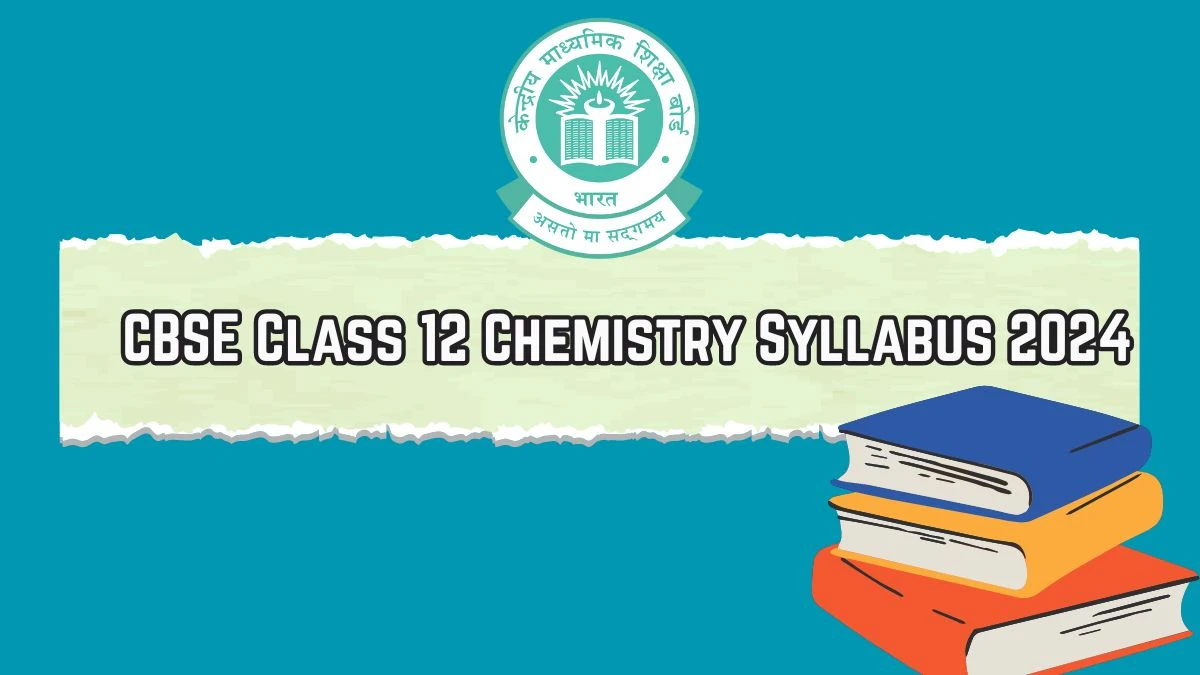- Rojgarlive »
- Education »
- CBSE Class 12 Chemistry Syllabus 2024 at cbse.gov.in Class 12 Chemistry Syllabus Pdf Download Here
CBSE Class 12 Chemistry Syllabus 2024 at cbse.gov.in Class 12 Chemistry Syllabus Pdf Download Here
by Keerthika
Updated May 21, 2024

CBSE Class 12 Chemistry Syllabus 2024 @ cbse.gov.in
The Central Board of Secondary Education (CBSE) has unveiled the updated Class 12 Chemistry syllabus for the academic year 2024-25. This latest CBSE 12th class Chemistry syllabus for 2024-25 is now available on the official CBSE board website - cbse.gov.in.
The Chemistry theory paper in CBSE will account for 70 marks, with an additional 30 marks allocated for practicals/internal assessment. Students must prioritize completing the Chemistry class 12 syllabus for 2024-25 on time.
Check - CBSE Class 12 Chemistry Syllabus 2024
|
S.No |
UNIT |
No. of Periods |
Marks |
|---|---|---|---|
|
1 |
Some Basic Concepts of Chemistry |
12 |
7 |
|
2 |
Structure of Atom |
14 |
9 |
|
3 |
Classification of Elements and Periodicity in Properties |
8 |
6 |
|
4 |
Chemical Bonding and Molecular Structure |
14 |
7 |
|
5 |
Chemical Thermodynamics |
16 |
9 |
|
6 |
Equilibrium |
14 |
7 |
|
7 |
Redox Reactions |
6 |
4 |
|
8 |
Organic Chemistry: Some basic Principles and Techniques |
14 |
11 |
|
9 |
Hydrocarbons |
12 |
10 |
|
TOTAL |
|
|
70 |
CBSE Class 12th Chemistry Topics 2024-25
|
Unit Name |
Topics |
|
Solutions |
Types of solutions, expression of concentration of solutions of solids in liquids, solubility of gases in liquids, solid solutions, Raoult's law, colligative properties - relative lowering of vapour pressure, elevation of boiling point, depression of freezing point, osmotic pressure, determination of molecular masses using colligative properties, abnormal molecular mass, Van't Hoff factor. |
|
Electrochemistry |
Redox reactions, EMF of a cell, standard electrode potential, Nernst equation and its application to chemical cells, Relation between Gibbs energy change and EMF of a cell, conductance in electrolytic solutions, specific and molar conductivity, variations of conductivity with concentration, Kohlrausch's Law, electrolysis and law of electrolysis (elementary idea), dry cell-electrolytic cells and Galvanic cells, lead accumulator, fuel cells, corrosion. |
|
Chemical Kinetics |
Rate of a reaction (Average and instantaneous), factors affecting rate of reaction: concentration, temperature, catalyst; order and molecularity of a reaction, rate law and specific rate constant, integrated rate equations and half-life (only for zero and first order reactions), concept of collision theory (elementary idea, no mathematical treatment), activation energy, Arrhenius equation |
|
d and f Block Elements |
General introduction, electronic configuration, occurrence and characteristics of transition metals, general trends in properties of the first-row transition metals – metallic character, ionization enthalpy, oxidation states, ionic radii, colour, catalytic property, magnetic properties, interstitial compounds, alloy formation, preparation and properties of K2Cr2O7 and KMnO4. |
|
Coordination Compounds |
Coordination compounds - Introduction, ligands, coordination number, colour, magnetic properties and shapes, IUPAC nomenclature of mononuclear coordination compounds. Bonding, Werner's theory, VBT, and CFT; structure and stereoisomerism, importance of coordination compounds (in qualitative analysis, extraction of metals and biological system). |
|
Haloalkanes and Haloarenes |
Haloalkanes: Nomenclature, nature of C–X bond, physical and chemical properties, optical rotation mechanism of substitution reactions. |
CBSE Class 12th Chemistry Syllabus 2024-25 for Practical Exams Topic-wise
|
Name |
Topic Included |
|
Surface Chemistry |
|
|
Chemical Kinetics |
(i) Reaction of Iodide ion with Hydrogen Peroxide at room temperature using different concentration of Iodide ions. |
|
Thermochemistry |
Any one of the following experiments: |
|
Electrochemistry |
Variation of cell potential in Zn/Zn2+|| Cu2+/Cu with change in concentration of electrolytes (CuSO4 or ZnSO4) at room temperature. |
|
Chromatography |
i) Separation of pigments from extracts of leaves and flowers by paper chromatography and determination of Rf values. |
How to Download CBSE Class 12 Chemistry Syllabus 2024-25
Here are the steps to download the latest CBSE Class 12 Chemistry Syllabus for the academic year 2024-25:
-
Open the website: cbse.gov.in
-
Navigate to the homepage and locate the 'Curriculum' section.
-
Click on the 'Curriculum 2024-25' link displayed in the Curriculum section.
-
You will be directed to a page where you can access various subjects' syllabi. Look for the link related to the Class 12 Chemistry syllabus.
-
Click on the Class 12 Chemistry syllabus link to download the PDF file.
-
Save the PDF file to your device for future reference and use.
CBSE Class 12 Chemistry Syllabus 2024-25? -FAQ
You have to obtain a minimum score of 33 percent in theory and practicals separately to pass the examination.
No, the questions are not exactly asked from the previous years’ question papers. However, the question of paper pattern could be the same.




